
Marangu Route
Marangu Route Benefits
Marangu is the only route on Kilimanjaro with overnight stays in huts. Excellent for rainy season climbs.
Mesmerizing scenic vistas of Mt Kilimanjaro await you. Visual euphoria and amazing photos guaranteed.
Each expedition is supplied with unlimited bottled oxygen for making acclimatization less stressful.
Our base-camp team at the foothills of majestic Kilimanjaro is always here tracking your expedition in a real-time mode.
Marangu Route - overview
The Marangu Route, often called the "Coca-Cola route," is the oldest path up Mount Kilimanjaro and one of the most popular ones. Opting for the Marangu route, you will repeat the very first successful Kilimanjaro summit by Hans Meyer that took place in 1889. The trail lies inside Kilimanjaro National Park, traversing all climatic zones of the mountain from tropical forest to alpine desert. Uniquely, it is the only route that offers dormitory-style huts for overnight stays.
Considering the Marangu Route? It's a good pick for climbing Kilimanjaro during the rainy seasons: from mid-March to late May, and from late October to late December because the huts will keep you dry and comfortable. The Marangu route is available in 5- and 6-day variations, with the second one being significantly less difficult.
Marangu Route - Expert Advice
The Marangu route offers scenic views of the southern slopes of Kilimanjaro. However, the fact that it uses the same path for ascent and descent limits the variety of sceneries and makes the trail fairly crowded. While the 5-day itinerary might sound tempting, it is much more challenging due to harsh acclimatization. So, beginners should consider the 6-day variation or any 7+ day itinerary on other routes.

Marangu Route Map
 Get PDF
Get PDF
Marangu Route - Summit Success Rate
During our 10 years of operating Kilimanjaro climbs, we’ve collected lots of data on every route regarding summit success rates. We believe those numbers to be fairly accurate. Below you can see the summit success rates on our Marangu route expeditions:
Marangu 5-day itinerary – Uhuru Peak: 83.8%; Crater Rim: 88.0%
Marangu 6-day itinerary – Uhuru Peak: 86.6%; Crater Rim: 93.14%
Note that the Marangu route 6-day itinerary has a higher summit success rate than its 5-day variation. Overall, the Marangu route itineraries have a lower summit success rate compared to routes such as Lemosho 7-day or Machame 7-day. This is due to the steeper acclimatization profile. While Marangu 6 is generally suitable for reasonably fit beginners, the 5-day variation is recommended only for experienced high-altitude trekkers or travelers with good prior acclimatization.
Note that the summit success rates for the Marangu route that we showed you are likely to be higher than those of most other operators. We attribute that fact to our talented and very experienced Kilimanjaro guides, extremely well-equipped expeditions, and detailed protocols for dealing with symptoms of altitude sickness – the main reason why hikers might fail to reach the peak during the summit night. Altezza Travel has the most extensive oxygen tank inventory in the region, full-sized and carefully assembled medical kits on every hike, and rigorous medical check-ups twice a day. All those factors ensure that you have the best chances of successfully acclimating to the altitude and reaching Uhuru Peak.

Prices for Marangu route
Our classic adventures are what the majority of climbers are looking for. The combination of great comfort and high safety standards makes our classic Kilimanjaro hikes enjoyable and memorable. This is the most popular option among our clients.
This climbing package includes everything that a climber may need for the hike - our experienced mountain crews, high-quality group equipment, nutritionist-designed meals. Our safety protocols, though, are the same for all our hiking adventures - only the guides with Wilderness First Responder certification are assigned to lead a party. Other safety measures include a supply of oxygen cylinders, complete medical kits and compulsory medical check-ups (two per day).
The progress of each trekking party is tracked with GPS device. You may share the link with your family and friends, who will be able to monitor your progress in a real-time mode.
Before and after the adventure you will stay in a good hotel with caring staff, hot water, reliable Wi-Fi, restaurant and swimming pool.
 Climbing Cost Includes
Climbing Cost Includes
Our Kilimanjaro packages cover all transfers outlined in the program. When you arrive at Kilimanjaro, one of our drivers will pick you up in a spacious and comfortable Toyota Alphard and take you to your hotel. Our cars have large trunks that can accommodate plenty of luggage. Inside you'll find complimentary bottled water (custom-ordered by Altezza Travel), a Wi-Fi hotspot, and wet wipes for your convenience. All our cars undergo regular examination and maintenance by our in-house team of technicians.
Our driving team consists of experienced and knowledgeable drivers, all of whom speak fluent English.
For the transfer to the trailhead of your climbing adventure, we will use Toyota Hiace or Coaster, which are better suited for navigating the wilderness terrain en route to Mt. Kilimanjaro. These cars are built to handle rough trails and ensure your safety.
At the end of your journey, we'll also provide you with a return transfer to the Kilimanjaro International Airport. With our comprehensive package, you can rest easy and enjoy the journey without concerns about your transportation.
The night before the climb and the night following the descent, you will be accommodated in a 3* hotel in the area of Moshi Town. By default - shared double occupancy room unless you order a single supplement. We always offer Aishi Machame Hotel and Brubru Lodge as the first option, as both hotels are owned and run by Altezza Travel. Should both of them be unavailable, you will be offered an alternative property with the matching comfort and service level. In your hotel, you will find everything a traveler needs: professional staff, a restaurant, a swimming pool, comfortable rooms with mosquito nets, laundry service, and complimentary Wi-Fi.
Aishi Machame is situated in a tranquil, green rural neighborhood, just 23 km (14.3 mi) from Moshi, and is often visited by monkeys, mongooses, and other wildlife, which you can observe from the restaurant terrace during breakfast. This location is perfect for those seeking peace and quiet. Our office and rental gear store are also located here.
Brubru Lodge is situated in the quietest area of Moshi, known as Shanty Town, and we recommend it to those who want to be closer to city life and explore local cafes, shops, and nightlife. If you need any gear for your climb from our gear store at Aishi Machame - don’t worry - our managers will deliver it right to Brubru Lodge for your orientation briefing.
By default, our packages include bed and breakfast accommodation. We also offer half-board and full-board upgrades at an additional cost.
Note:You will be sharing a room with your travel companion, or, if traveling solo, with a same-sex traveler. If you prefer to have a single room, please order a single supplement as soon as you can, as our hotels often have many guests, and the rooms may be fully booked by the time of your arrival. Also, should you decide to descend earlier than planned, a charge for all extra nights spent in our hotels will apply. Contact your travel consultant to book a single room.
On the day before the climb, our managers will meet you in your hotel for an orientation briefing, and our car will pick you up for the start of your Kilimanjaro adventure.
Altezza Travel offers a Kilimanjaro adventure with all the necessary amenities for a safe and comfortable camping experience.
Developed to withstand strong winds and heavy rains, these 4-season tents provide a cozy atmosphere inside. Tent entrances are easy to open and close and provide a comfortable buffer zone. Rest assured that the ever-changing equatorial weather on Kilimanjaro will not disturb your much-needed sleep.
As of today, these tents are without question the best choice for the Kilimanjaro adventure, and Altezza Travel is the only company to have them.
Please note: by default, you'll be sharing a tent with your travel companion or other same-sex co-hiker (unless you've ordered a private hike). Though designed for three people, each Altezza tent sleeps only two hikers on our adventures. Single supplements are available at an extra charge. Contact your manager for more details.
Our hikes include 3-inch sleeping mats produced by our company’s tailor shop, which is located right at our Machame climbing base.
Camping tables with stainless steel cutlery and ceramics crockery
They are served and cleaned by a dedicated kitchen crew at each meal. At Altezza Travel, we are committed to reducing plastic waste and never use disposable tableware.
Produced for Altezza by RedFox, a reputable brand and manufacturer of outdoor equipment, our dining tents are strong, wind- and rainproof, allowing for a comfortable dining and socializing experience, even in bad weather.
Durable and comfortable chairs that provide excellent back and arm support, they’ll make evening get-togethers in the mess tents a pleasant pastime with your teammates. Grab one and enjoy an epic sunset from the edge of the camp!
Our camp crew regularly fill it with hot water so that you can keep your hands and face clean.
The camp managers arrive at the camping grounds hours ahead of your group to pick the most picturesque location at a distance from other hiking groups. They also keep a close eye on the tents and other camping equipment to ensure everything runs smoothly. Each camp manager carries a repair kit in case a quick maintenance is needed, although our expedition managers inspect each tent before the expedition starts, making such situations unlikely.
Our mountain chefs and waiters will take care of preparing and serving your breakfasts, lunches, and dinners throughout the adventure. The menu has been designed in consultation with a professional dietitian to ensure that our meals are both delicious and energy-rich, providing hikers with the necessary nutrition.
At Altezza Travel, we understand that everyone has unique dietary needs. That's why we offer delicious vegetarian, vegan, gluten-free, lactose-free, and other types of meal plans for our mountain adventures. Just let your manager know, and our mountain chef will be ready to prepare a meal that meets your requirements. Best of all, switching to a special meal plan won't cost you a thing.
For example, for breakfast, you can expect to enjoy porridge, vegetables, eggs, sausages, sweet potato, spinach cooked in a local fashion ("mchicha"), and coffee or tea. For lunch, we usually serve various soups (butternut, tomato, leek, vegetable, beef); spaghetti; stews; avocado salads; mashed potato; fried chicken with coconut, tomato, garlic and other sauces; minced meat in tomato sauce, and other popular international and local meals.
Similarly, for dinner, you can expect a soup; vegetable salad (locally styled "Kachumbari"); Mexican salad with tomatoes, corn, and onion, avocado; a juicy stew (such as bamia stew); fried vegetables; various main dishes with chicken, beef or fish. All meals are served with tasty sauces, and extra seasonings are always available on the table. After each meal, our waiters serve fresh local fruits, such as mangoes, oranges, pineapple, and bananas, to give hikers a vitamin boost.
We use organic, locally grown fruits, vegetables, and meat from neighboring farms to supply our trips. Our team rigorously checks each provider to ensure that it has a certification from the Tanzania Food and Drugs Authority (TFDA). Altezza Travel also prefers to choose small local farms instead of large agricultural companies. This way, we ensure that all produce is always fresh and organic and that our expeditions provide a meaningful impact on the local economy.
Our mountain chefs will prepare all meals during the expedition, except for lunch on the first day of your trip, which you will have after entering the park and before reaching the first camp where we will set up our kitchen. Our restaurant chefs at Aishi Machame Hotel will prepare this first lunch, and we will pack it for your adventure in sturdy compostable packaging from Vegware, our UK-based supplier of eco-friendly food packaging.
When evaluating the quality of our meals on Kilimanjaro, please keep in mind that our teams prepare them in very challenging conditions. Our mountain chef prepares meals in a camp kitchen, using a camping gas oven with an electric torch for lighting. At times, weather conditions can be harsh, with wind and rain, and during certain months, it can be quite cold. While our mountain chef strives to create delicious and visually appealing meals, the unpredictable weather and challenging camping conditions may occasionally impact the quality and appearance of our dishes. We work tirelessly to maintain a high level of performance in such a demanding environment.
On your adventure you will be led by our outstanding Kilimanjaro mountain guides.
Each guide has at least seven years of experience and boasts excellent knowledge of the Mt Kilimanjaro terrain, flora, and fauna. They have been chosen to lead some of the most incredible expeditions and adventures on the mountain, such as Wings of Kilimanjaro or Red Bull’s Kilimanjaro wingsuit BASE jump, which are yet to be repeated by anyone else. They also took part in the high-speed Kilimanjaro ascent of Nimsdai (aka Nirmal Purja) whose story is told in the Netflix Documentary "14 Peaks: Nothing is Impossible".
You are in safe hands: all our mountain guides are certified Wilderness First Responders. This certification is administered by the independent USA-based organization ("Wilderness Medical Associates") and confirms that the certificate holders are well-trained to respond to any emergencies, which may happen in the wilderness. This WFR badge, together with excellent knowledge of the routes and locations, is a pre-condition for taking a mountain leader position in our company.
Altezza guides are good story-tellers, and will always be happy to entertain you with Kilimanjaro legends and tales. You will also learn a lot about the plants, animals, and history of the highest free-standing mountain in the world. For those interested, our mountain team will be a rich source of information about the local culture, lifestyle, and customs.
In the meantime, the guides are considerate and know when to take a step back to let you enjoy some peace and quiet alone. Whenever you want to enjoy some solitude with nature, our guides will quietly retreat to the background.
The guides will be supported by our hard-working porters, camp managers, and other members of the crew. They will pitch up the camp ahead of your arrival, bring water from the mountain streams, and carry all of the expedition's supplies and gear. The mountain chefs will attend to the camp kitchen to provide you with nutritious and tasty meals.
Altezza Travel is proud to pay the highest salaries to our mountain crews in the Tanzanian tourism industry. Also, we open individual bank accounts for each member of the expedition team to ensure transparency and accountability of salary payouts. Taking good care of our mountain crews is the foundation of our work.
Due to that, our guiding team receives positive reviews daily. They are undoubtedly the key reason we are ranked as the #1 Kilimanjaro trekking company on TripAdvisor.
Altezza Travel is a member of the Kilimanjaro Porters Assistance Project (KPAP) - an independent organization that advocates for the fair treatment of porters working on Kilimanjaro. KPAP certification is proof that our company treats its porters ethically and provides them with a safe and comfortable working environment.
We carry bottled oxygen supplies for each Altezza Travel expedition. The guiding team uses it to make the high-altitude acclimatization process easier and prevent acute mountain sickness (AMS). Our guides administer bottled oxygen as soon as a climber develops the first signs of AMS, and that typically stabilizes the oxygen saturation, allowing them to continue the adventure.
At Altezza Travel, we never run short on oxygen supplies. In the unlikely event of a crisis requiring larger amounts of oxygen for one of our teams, other Altezza crews from the same camp will always come to help and share their supplies. As the largest operator on Kilimanjaro operating 15% of all on Kilimanjaro, we have multiple Altezza teams located in different camps at the same time. Besides, we can organize a fast (less than six hours) delivery from our climbing base.
Many of the companies operating on Kilimanjaro say that they have oxygen bottles on their expeditions as well. However, the devil is in the details, and the key thing to look at is how the guides use it.
Most of them provide oxygen to their clients at the late stages of AMS, when evacuation is the only remedy. Altezza is the only company here that uses bottled oxygen as an AMS prevention technique. This approach translates into less stressful acclimatization, significantly fewer AMS cases, and a successful Kilimanjaro experience.
Nowadays, Altezza Travel is the most oxygen-conscious trek outfitter on Kilimanjaro. We have a staff member whose sole responsibility is to oversee our oxygen storage and ensure that our bottles are always filled, the valves are functioning properly, and each crew receives the right amount of oxygen. As of today, we have 350 portable expedition oxygen systems.
Each expedition is equipped with a reliable GPS tracking device, allowing us to track our Kilimanjaro teams in real-time. While primarily a safety protocol, the GPS links also provide peace of mind for your loved ones who can track the hikers’ progress from home.
The morning your Kilimanjaro expedition begins, our adventure consultant will give you a QR code that can be scanned to generate a GPS link. In addition, this link will also be accessible through your personal account at Altezza Personal Trip Board.
Every morning and evening on the hike, our WFR-certified guides perform medical check-ups to ensure that both hikers and crew members (including porters, camp managers, and chefs) are properly acclimating to the altitude. During these check-ups, our guides will ask general questions about your health and measure your oxygen saturation level. In some cases, they may also need to check your blood pressure or listen to your lungs with a stethoscope to assess your breathing.
It's mandatory for all hikers to attend those medical check-ups, even for those who feel great and don't have any altitude-related symptoms. They allow our guiding team to diagnose the early stages of AMS (Acute Mountain Sickness) and take preventive measures to ensure that everyone is acclimating properly and that the hike is a pleasant and safe adventure.
At Altezza Travel, we are experienced in accommodating climbers with various health conditions, such as diabetes, and asthma, among others. We have developed special protocols to ensure that those climbers receive the support and care they need during their climb. We understand that climbing Mt. Kilimanjaro can be challenging, especially for those with underlying health conditions. That's why we work closely with our climbers to understand their individual needs and develop a plan that ensures their safety and well-being throughout the climb.
If our guides have any concerns about a hiker's health, they use the Lake Louise Acute Mountain Sickness scoring system and additionally consult with our company doctor before deciding whether a hiker is safe to continue the ascent. With our comprehensive medical kits and experienced guides, we prioritize the safety and well-being of our climbers during their Kilimanjaro adventure.
Our in-company doctor carefully previews all pre-departure health forms, completed by the hikers on the Altezza Personal Trip Board. He ensures that each participant is indeed ready for the adventure, and provides health-related recommendations if needed.
At all times our central goal is for your Kilimanjaro climb to be a safe and memorable experience. For that to happen we will be strictly following our protocols and doing as much as we can to never compromise your safety on Kilimanjaro.
At Altezza Travel, we take every precaution to ensure the safety and well-being of our climbers. To this end, we maintain a special medical record book for each participant that documents all relevant medical information throughout the trip. This is a critically important resource that will be available to doctors in the unlikely event of hospitalization during the expedition.
Your personal information will remain strictly confidential and not disclosed, unless necessary for the medical personnel.
Altezza Travel sets high standards for ensuring hikers' health and safety, which is why each climbing crew carries multiple medical kits. These include large "camp" medical kits that contain medication for various mountain-related illnesses. There are 49 different types of medications and items in a kit, making it one of the most complete emergency kits in Tanzania.
In addition to the group medical kit, each guide also carries a tactical medical kit with hemostatic plasters, tourniquets, painkillers, and anything else that may be needed during emergencies and while moving from one camp to another. Our guides are always prepared to treat twisted ankles and arms, strained muscles or tendons, and other injuries.
We have been operating in Tanzania for almost ten years, and during this time, not a single medical kit has ever been used to its fullest extent. However, we firmly believe that being prepared for any situation is one of the reasons why Altezza Travel is the safest company to climb Mt. Kilimanjaro with.
In addition, Altezza Travel has a VIP ward reserved for our clients on a stand-by basis in the KCMC hospital where our clients who experience high-altitude sickness receive priority examination and treatment. In the unlikely event of evacuation, our clients will not have to wait in line in the emergency unit and will receive the attention of a personal nurse instead. Moreover, in the very rare event that an Altezza hiker requires hospitalization, they receive regular tasty food and drink deliveries from our company restaurant in Moshi. A personal company manager is always available to assist with anything they may need. The ward has reliable free Wi-Fi connectivity.
Altezza Kilimanjaro trips are fully inclusive of all park fees that every Kilimanjaro hiker is liable to pay. This includes camping and conservation fees, rescue fee, crew fee, forest fee (on certain routes), and other payments. These payments make up about half of the total price and are one of the reasons why Mt Kilimanjaro hiking tours are more expensive compared to the other popular destinations.
As a law-abiding and transparent company, Altezza Travel pays all taxes in Tanzania such as VAT (18%), corporate income taxes (30%) and labor-related levies and duties, licensing fees and social security deductions for our employees, all of whom are officially employed by Altezza Travel. We are proud to be one of the few travel companies in Tanzania doing that.
The taxes we pay are later spent for the betterment of the lives of the local communities here. In 2022, our company paid over $500,000/- in taxes and other levies.
When you book with Altezza Travel, your tour will be in the good hands of 200 dedicated professionals who are committed to ensuring that your tour is an amazing experience. Our team includes experts in reservation, transfer planning, expeditions, customer experience, logistics, and other areas, each responsible for their specific role in the process. We also have large hotel, store-keeping, transfer and other teams, whose contribution is essential and always available. They work together seamlessly to ensure that every aspect of your tour is carefully planned and executed to the highest standard.
The travel consultants team is available to assist you 24/7. You can easily reach out to your manager through various channels such as messengers, email, phone, or any other convenient method. We are always here to answer your questions and address any concerns you may have, and our support team works across different time zones.
Altezza Travel is the first adventure operator in Tanzania to develop its own travel planning software. With our new system, you no longer need to provide long lists of information via email. Instead, you can simply fill out the Personal Trip Board in the Altezza Family travel portal.
This user-friendly platform allows you to provide us with details about the gear you'd like to hire for your climb (if any), arrival and departure information, dietary plan, insurance and passport information for the necessary permits and for the summit certificate. You can also use the form to inform us about any allergies or important medical information that we should be aware of before you start your climb.
The security of your personal information is of utmost importance to our team. Our system is fully secure and uses SSL encryption provided by Cloudflare Inc, a leading provider of cloud security services worldwide. This means that all data transmitted through our system is fully encrypted and secure. Rest assured that only authorized personnel at Altezza Travel will have access to your data.
Unlike other companies where a sales manager acts as an intermediary between you and the local operations team in Tanzania, our system transmits your information directly to the dashboard of the person in charge. This direct communication line vastly minimizes the chance of human error.
For example, let's say you've indicated your arrival time in our system. In the past, your manager would have had to manually add it to our calendar, and our transfer manager would have had to assign a driver. With so many people arriving in Tanzania, there was always a risk of human error.
But with the new communication system, your arrival time information is instantly transmitted to the dashboard of our transfer manager. The system automatically assigns an available driver to your trip, and activates GPS tracking to monitor their progress. If the driver misses any check-points on the way, the system will alert the transfer manager to take corrective action and ensure that you're picked up on time.
We use similar streamlined communication flows for all our travel operations. For instance, your medical information is sent directly to our in-house doctor on the expeditions team, and your dietary requirements are shared with our camp kitchen team. With this system, you can be confident that every detail of your trip is taken care of and that there's zero risk of losing any critical information along the way.
What's more, our user-friendly system is designed to make travel planning fun and engaging. In addition to the intuitive interface, we've added a special feature that turns filling in the required information into a game. As you provide the necessary details for the organization of your trip, you'll receive pop-ups with interesting information about African animals. This way, you can learn more about the wildlife you'll be seeing during your adventure while completing the travel-related paperwork.
At Altezza Travel, we believe that travel planning should be easy, enjoyable, and informative. Our innovative system is just one of the many ways we strive to provide exceptional service to our clients.
We understand that some things that you bring with you to Tanzania won't be necessary for your Kilimanjaro climb, such as suitcases, clothes for safari or other parts of your trip, laptops, gadgets, and documents. We recommend that you take only what's truly essential for your expedition to the mountain, and leave fragile or easily stainable items at our storage facilities or a safe room.
The use of a storage room and a safe room is completely free of charge.
To give you peace of mind while you enjoy the wonders of Kilimanjaro, we have built a secure storage facility where you can safely leave all your suitcases and handbags. The facility is dry, well-ventilated, and only accessible to Altezza Travel staff.
For items that require special handling, such as cash, jewelry, passports, gadgets, and other valuables, Altezza offers space in our safe room. This room is under 24/7 video surveillance and protected by armed guards. It features a fire-proof door with a 120-minute fire resistance rating, 10-inch brick walls, and a highly sensitive alarm system
You won't need any cash on Kilimanjaro as there are no shops, vending machines, or other places where one can spend money. The Mount Kilimanjaro National Park Development Plan strictly prohibits the construction of any commercial facilities on the park's premises.
The small souvenir shop at Mweka Gate, which is the exit point for most of the trails, is the only place to buy souvenirs in the vicinity of Kilimanjaro. Local artisans sell their wares there, and it may be interesting for some of the hikers. However, we recommend bringing no more than $100 as the larger and more interesting souvenir shops are located in Arusha. If you're planning to spend more, we suggest visiting those shops instead, as they offer a better selection and prices.
If you want to deposit your valuables in our care, you will need to itemize them and fill in a special form. If you leave cash with us, we will use a cash counter machine to help you count the money. You’ll get a receipt, listing the cash left in our care. You will sign it, and we will have it sealed together in your presence.
To ensure transparency, we record the process with a high-resolution camera, and all records are deleted 30 days after you leave Tanzania.
Our safe room is insured for $600,000 for emergencies but in the almost ten years of our operation in Tanzania, we have not had a single insurance case.
At Altezza Travel, we take pride in offering environmentally friendly treks. Our goal is to leave Kilimanjaro cleaner after every expedition. To achieve this goal, we assign a special team to ensure that our climbing crew and customers leave no waste on the mountain. This team also collects any waste left by litterbugs from other groups on the trek, so we can keep Kilimanjaro looking as pristine as it did during the times of Hans Meyer and Ludwig Purtscheller, who are credited with being the first Europeans to reach the summit of Mount Kilimanjaro.
We are committed to minimizing the use of plastic in our expeditions whenever possible. For instance, the packaging for the lunchboxes on the first day of your trip (hot lunch is provided on all other days) is compostable. We source our packaging from Vegware, a leading UK-based provider of food packaging with a strong environmental focus.
When you choose Altezza Travel for your trip, you're making a meaningful contribution to the development of local communities in Kilimanjaro. We're committed to sustainability, and as part of our pledge, we allocate a part of our profits to various social responsibility initiatives. Here are some examples:
- Our guides regularly participate in firefighting efforts on the slopes of Kilimanjaro. Climate change is affecting even relatively remote countries like Tanzania, and unfortunately, we've seen a significant increase in bushfires in recent years. When two large fires erupted on Kilimanjaro in 2020 and 2022, our expeditions team was among the first to respond. It was later discovered that our strong team of 150 porters was larger and more productive than all other crews sent by all the other operators combined.
- We're proud to be one of the first donors to the Serengeti De-snaring Project, a conservation initiative of the Frankfurt Zoological Society. The project is working to remove snares, traps, and other poaching devices from Tanzania's national parks.
- Altezza Travel is a member of the Kilimanjaro Porters Assistance Project (KPAP), which promotes fair porter treatment practices and provides certification to tour operators that meet its standards. Our certification means that we pay fair wages, provide nutritious hot meals to our team members, and offer them proper care and protection. You can learn more about KPAP's work on their website.
- In response to the growing crisis of deforestation, we have undertaken several large-scale tree-planting efforts on the foothills of Mount Kilimanjaro and in the surrounding areas. We are currently planning additional reforestation activities to further combat the issue.
- Altezza Travel is on a mission to improve the lives of students in the remote Materuni area. Over 50 local students have been attending a school with dilapidated classrooms, a leaking roof, and a lack of essential educational materials. The teachers have been doing their best to maintain a positive learning environment, but they are struggling with limited resources. That's where Altezza Travel stepped in. We began funding the renovation of the school, providing building materials, and supplying educational materials as well as sports equipment. Our goal is to create a brighter future for these children by providing them with the tools and resources they need to succeed.
- In 2023, we partnered with Nature Tanzania and invested over $12,000 to save the population of the Long-billed Forest Warbler. A special conservation site has been established in the Amani Forest, where our team conducts extensive research and conservation operations. With fewer than 250 birds remaining, this species is considered 'critically endangered' by the International Union for Conservation of Nature, and urgent action is needed to prevent their extinction.
- Finally, we're committed to using local suppliers for all our operations and have made a deliberate decision to avoid large agricultural companies in favor of small farmers from the surrounding communities.
At Altezza Travel, we support only meaningful and impactful projects that bring real change to local communities. Each application we receive from local NGOs or eco-activists is carefully scrutinized by our board before we allocate funding.
By participating in our climbs, you're directly supporting positive change in the communities around Mount Kilimanjaro. You may read more about the social responsibility efforts you are going to support on this page of our website.
 Climbing Cost Excludes
Climbing Cost Excludes
Our Kilimanjaro packages don’t include international flights. You’ll be responsible for covering those costs separately. Feel free to contact your manager to get recommendations about the airlines operating flights to Tanzania.
Tipping your climbing crew is a well-established practice in mountain hiking all over the world. Though never mandatory at Altezza Travel, our clients are encouraged to tip their mountain crews if their performance is up to your expectations. A recommended amount is USD 250-350 per participant.
You may read more about tipping in our article here.
Most nationals are required to pay USD 50 for a one-time, single-entry 90-day visa. USA nationals, however, are required to pay $100 for a multi-entry visa. Contact our travel advisors to learn more about Tanzania visa rules and requirements.
When climbing Mount Kilimanjaro, you will need personal gear such as hiking boots, sleeping bags, trekking pants, thermals, and trekking poles. See the full list here.
As of today, Altezza Travel’s gear rental shop is the only gear rental shop on Kilimanjaro where climbers can rent everything they need for their adventure. All of our gear comes from top brands such as The North Face, Black Diamond, RedFox, Columbia, Marmot, Mountain Hardwear, and others.
If you intend to rent gear from us, you can provide us with a list of everything you will need to hire in your Altezza Family portal account, and we will have everything prepared for you before you arrive in Tanzania.
Our group expeditions include shared accommodation, which means you'll be sharing a hotel room and a tent with either your travel companion or a same-sex member of your travel group. If you prefer a private room and/or tent, please let us know. Single supplements are available for an additional charge. Single supplement is not available on the Marangu route where you stay overnight in huts that can accommodate up to 20 hikers.
Travel insurance is not included in our climbing packages. For our Kilimanjaro and Meru hiking adventures, all participants are required to have travel insurance that covers trekking to altitudes of up to 6000 meters and a helicopter evacuation. Since the requirements and costs of insurance vary across different countries, please contact your insurance provider to make sure that those requirements are covered, and find out about the exact costs.
Currently, the cost of portable toilets is not included in the tour package to reduce trip expenses. Public restrooms are available in camps along the way. However, for those who prioritize comfort, renting a portable toilet is highly recommended. You can contact our travel consultants to learn more about this option. Portable toilet is not available on the Marangu route due to the Kilimanjaro National Park regulations.
Included accommodation in the hotel is on a bed & breakfast basis. It means that you will need to pay for the lunch and dinner either at our hotel restaurant or if you decide to dine out - at any other place in Moshi.
Our premium Kilimanjaro adventures include extra features such as spacious walk-in tents, advanced meal plan on the hike, portable toilet, camping cots, satellite phone to stay in touch with your family and friends and some other upgrades on Kilimanjaro. It is the highest quality service a luxury-focused climber can get here!
Safety protocols for the premium adventures include mandatory Wilderness First Responder Certification of all our guides, oxygen cylinders, medical kits and compulsory medical check-ups (two per day).
Before and after your trip you will be staying in a 5* hotel in Arusha (breakfast and dinner included).
 Climbing Cost Includes
Climbing Cost Includes
Our Kilimanjaro packages cover all transfers outlined in the program. When you arrive at Kilimanjaro, one of our drivers will pick you up in a spacious and comfortable Toyota Alphard and take you to your hotel. Our cars have large trunks that can accommodate plenty of luggage. Inside you'll find complimentary bottled water (custom-ordered by Altezza Travel), a Wi-Fi hotspot, and wet wipes for your convenience. All our cars undergo regular examination and maintenance by our in-house team of technicians.
Our driving team consists of experienced and knowledgeable drivers, all of whom speak fluent English.
For the transfer to the trailhead of your climbing adventure, we will use Toyota Hiace or Coaster, which are better suited for navigating the wilderness terrain en route to Mt. Kilimanjaro. These cars are built to handle rough trails and ensure your safety.
At the end of your journey, we'll also provide you with a return transfer to the Kilimanjaro International Airport. With our comprehensive package, you can rest easy and enjoy the journey without concerns about your transportation.
- Accommodation at 5* Legendary Lodge (Arusha) one night before and one night after the expedition. Legendary Lodge is the ultimate premium retreat with the highest service standards to be found in northern Tanzania;
- Tented accommodation on Mount Kilimanjaro (spacious, custom-designed, 4-season walk-in tents).
Please note: by default, you will share a room and a tent with your travel companion. Single occupancy is available upon request.
Altezza Travel offers a Kilimanjaro adventure with all the necessary amenities for a safe and comfortable camping experience.
Developed to withstand strong winds and heavy rains, these 4-season tents provide a cozy atmosphere inside. Tent entrances are easy to open and close and provide a comfortable buffer zone. Rest assured that the ever-changing equatorial weather on Kilimanjaro will not disturb your much-needed sleep.
As of today, these tents are without question the best choice for the Kilimanjaro adventure, and Altezza Travel is the only company to have them.
Please note: by default, you'll be sharing a tent with your travel companion or other same-sex co-hiker (unless you've ordered a private hike). Though designed for three people, each Altezza tent sleeps only two hikers on our adventures. Single supplements are available at an extra charge. Contact your manager for more details.
Our hikes include 3-inch sleeping mats produced by our company’s tailor shop, which is located right at our Machame climbing base.
Camping tables with stainless steel cutlery and ceramics crockery
They are served and cleaned by a dedicated kitchen crew at each meal. At Altezza Travel, we are committed to reducing plastic waste and never use disposable tableware.
Produced for Altezza by RedFox, a reputable brand and manufacturer of outdoor equipment, our dining tents are strong, wind- and rainproof, allowing for a comfortable dining and socializing experience, even in bad weather.
Durable and comfortable chairs that provide excellent back and arm support, they’ll make evening get-togethers in the mess tents a pleasant pastime with your teammates. Grab one and enjoy an epic sunset from the edge of the camp!
Our camp crew regularly fill it with hot water so that you can keep your hands and face clean.
The camp managers arrive at the camping grounds hours ahead of your group to pick the most picturesque location at a distance from other hiking groups. They also keep a close eye on the tents and other camping equipment to ensure everything runs smoothly. Each camp manager carries a repair kit in case a quick maintenance is needed, although our expedition managers inspect each tent before the expedition starts, making such situations unlikely.
Our mountain chefs and waiters will take care of preparing and serving your breakfasts, lunches, and dinners throughout the adventure. The menu has been designed in consultation with a professional dietitian to ensure that our meals are both delicious and energy-rich, providing hikers with the necessary nutrition.
At Altezza Travel, we understand that everyone has unique dietary needs. That's why we offer delicious vegetarian, vegan, gluten-free, lactose-free, and other types of meal plans for our mountain adventures. Just let your manager know, and our mountain chef will be ready to prepare a meal that meets your requirements. Best of all, switching to a special meal plan won't cost you a thing.
For example, for breakfast, you can expect to enjoy porridge, vegetables, eggs, sausages, sweet potato, spinach cooked in a local fashion ("mchicha"), and coffee or tea. For lunch, we usually serve various soups (butternut, tomato, leek, vegetable, beef); spaghetti; stews; avocado salads; mashed potato; fried chicken with coconut, tomato, garlic and other sauces; minced meat in tomato sauce, and other popular international and local meals.
Similarly, for dinner, you can expect a soup; vegetable salad (locally styled "Kachumbari"); Mexican salad with tomatoes, corn, and onion, avocado; a juicy stew (such as bamia stew); fried vegetables; various main dishes with chicken, beef or fish. All meals are served with tasty sauces, and extra seasonings are always available on the table. After each meal, our waiters serve fresh local fruits, such as mangoes, oranges, pineapple, and bananas, to give hikers a vitamin boost.
We use organic, locally grown fruits, vegetables, and meat from neighboring farms to supply our trips. Our team rigorously checks each provider to ensure that it has a certification from the Tanzania Food and Drugs Authority (TFDA). Altezza Travel also prefers to choose small local farms instead of large agricultural companies. This way, we ensure that all produce is always fresh and organic and that our expeditions provide a meaningful impact on the local economy.
Our mountain chefs will prepare all meals during the expedition, except for lunch on the first day of your trip, which you will have after entering the park and before reaching the first camp where we will set up our kitchen. Our restaurant chefs at Aishi Machame Hotel will prepare this first lunch, and we will pack it for your adventure in sturdy compostable packaging from Vegware, our UK-based supplier of eco-friendly food packaging.
When evaluating the quality of our meals on Kilimanjaro, please keep in mind that our teams prepare them in very challenging conditions. Our mountain chef prepares meals in a camp kitchen, using a camping gas oven with an electric torch for lighting. At times, weather conditions can be harsh, with wind and rain, and during certain months, it can be quite cold. While our mountain chef strives to create delicious and visually appealing meals, the unpredictable weather and challenging camping conditions may occasionally impact the quality and appearance of our dishes. We work tirelessly to maintain a high level of performance in such a demanding environment.
- Portable toilet.
- 4-inch (10-cm) thick and comfortable sleeping mats;
- Camping cots;
- Sleeping bag Mountain Hardwear Lamina (Comfort -29°C/-20F);
- Satellite phone (20 min credit included, 3 USD per every extra min).
On your adventure you will be led by our outstanding Kilimanjaro mountain guides.
Each guide has at least seven years of experience and boasts excellent knowledge of the Mt Kilimanjaro terrain, flora, and fauna. They have been chosen to lead some of the most incredible expeditions and adventures on the mountain, such as Wings of Kilimanjaro or Red Bull’s Kilimanjaro wingsuit BASE jump, which are yet to be repeated by anyone else. They also took part in the high-speed Kilimanjaro ascent of Nimsdai (aka Nirmal Purja) whose story is told in the Netflix Documentary "14 Peaks: Nothing is Impossible".
You are in safe hands: all our mountain guides are certified Wilderness First Responders. This certification is administered by the independent USA-based organization ("Wilderness Medical Associates") and confirms that the certificate holders are well-trained to respond to any emergencies, which may happen in the wilderness. This WFR badge, together with excellent knowledge of the routes and locations, is a pre-condition for taking a mountain leader position in our company.
Altezza guides are good story-tellers, and will always be happy to entertain you with Kilimanjaro legends and tales. You will also learn a lot about the plants, animals, and history of the highest free-standing mountain in the world. For those interested, our mountain team will be a rich source of information about the local culture, lifestyle, and customs.
In the meantime, the guides are considerate and know when to take a step back to let you enjoy some peace and quiet alone. Whenever you want to enjoy some solitude with nature, our guides will quietly retreat to the background.
The guides will be supported by our hard-working porters, camp managers, and other members of the crew. They will pitch up the camp ahead of your arrival, bring water from the mountain streams, and carry all of the expedition's supplies and gear. The mountain chefs will attend to the camp kitchen to provide you with nutritious and tasty meals.
Altezza Travel is proud to pay the highest salaries to our mountain crews in the Tanzanian tourism industry. Also, we open individual bank accounts for each member of the expedition team to ensure transparency and accountability of salary payouts. Taking good care of our mountain crews is the foundation of our work.
Due to that, our guiding team receives positive reviews daily. They are undoubtedly the key reason we are ranked as the #1 Kilimanjaro trekking company on TripAdvisor.
Altezza Travel is a member of the Kilimanjaro Porters Assistance Project (KPAP) - an independent organization that advocates for the fair treatment of porters working on Kilimanjaro. KPAP certification is proof that our company treats its porters ethically and provides them with a safe and comfortable working environment.
We carry bottled oxygen supplies for each Altezza Travel expedition. The guiding team uses it to make the high-altitude acclimatization process easier and prevent acute mountain sickness (AMS). Our guides administer bottled oxygen as soon as a climber develops the first signs of AMS, and that typically stabilizes the oxygen saturation, allowing them to continue the adventure.
At Altezza Travel, we never run short on oxygen supplies. In the unlikely event of a crisis requiring larger amounts of oxygen for one of our teams, other Altezza crews from the same camp will always come to help and share their supplies. As the largest operator on Kilimanjaro operating 15% of all on Kilimanjaro, we have multiple Altezza teams located in different camps at the same time. Besides, we can organize a fast (less than six hours) delivery from our climbing base.
Many of the companies operating on Kilimanjaro say that they have oxygen bottles on their expeditions as well. However, the devil is in the details, and the key thing to look at is how the guides use it.
Most of them provide oxygen to their clients at the late stages of AMS, when evacuation is the only remedy. Altezza is the only company here that uses bottled oxygen as an AMS prevention technique. This approach translates into less stressful acclimatization, significantly fewer AMS cases, and a successful Kilimanjaro experience.
Nowadays, Altezza Travel is the most oxygen-conscious trek outfitter on Kilimanjaro. We have a staff member whose sole responsibility is to oversee our oxygen storage and ensure that our bottles are always filled, the valves are functioning properly, and each crew receives the right amount of oxygen. As of today, we have 350 portable expedition oxygen systems.
Each expedition is equipped with a reliable GPS tracking device, allowing us to track our Kilimanjaro teams in real-time. While primarily a safety protocol, the GPS links also provide peace of mind for your loved ones who can track the hikers’ progress from home.
The morning your Kilimanjaro expedition begins, our adventure consultant will give you a QR code that can be scanned to generate a GPS link. In addition, this link will also be accessible through your personal account at Altezza Personal Trip Board.
Every morning and evening on the hike, our WFR-certified guides perform medical check-ups to ensure that both hikers and crew members (including porters, camp managers, and chefs) are properly acclimating to the altitude. During these check-ups, our guides will ask general questions about your health and measure your oxygen saturation level. In some cases, they may also need to check your blood pressure or listen to your lungs with a stethoscope to assess your breathing.
It's mandatory for all hikers to attend those medical check-ups, even for those who feel great and don't have any altitude-related symptoms. They allow our guiding team to diagnose the early stages of AMS (Acute Mountain Sickness) and take preventive measures to ensure that everyone is acclimating properly and that the hike is a pleasant and safe adventure.
At Altezza Travel, we are experienced in accommodating climbers with various health conditions, such as diabetes, and asthma, among others. We have developed special protocols to ensure that those climbers receive the support and care they need during their climb. We understand that climbing Mt. Kilimanjaro can be challenging, especially for those with underlying health conditions. That's why we work closely with our climbers to understand their individual needs and develop a plan that ensures their safety and well-being throughout the climb.
If our guides have any concerns about a hiker's health, they use the Lake Louise Acute Mountain Sickness scoring system and additionally consult with our company doctor before deciding whether a hiker is safe to continue the ascent. With our comprehensive medical kits and experienced guides, we prioritize the safety and well-being of our climbers during their Kilimanjaro adventure.
Our in-company doctor carefully previews all pre-departure health forms, completed by the hikers on the Altezza Personal Trip Board. He ensures that each participant is indeed ready for the adventure, and provides health-related recommendations if needed.
At all times our central goal is for your Kilimanjaro climb to be a safe and memorable experience. For that to happen we will be strictly following our protocols and doing as much as we can to never compromise your safety on Kilimanjaro.
At Altezza Travel, we take every precaution to ensure the safety and well-being of our climbers. To this end, we maintain a special medical record book for each participant that documents all relevant medical information throughout the trip. This is a critically important resource that will be available to doctors in the unlikely event of hospitalization during the expedition.
Your personal information will remain strictly confidential and not disclosed, unless necessary for the medical personnel.
Altezza Travel sets high standards for ensuring hikers' health and safety, which is why each climbing crew carries multiple medical kits. These include large "camp" medical kits that contain medication for various mountain-related illnesses. There are 49 different types of medications and items in a kit, making it one of the most complete emergency kits in Tanzania.
In addition to the group medical kit, each guide also carries a tactical medical kit with hemostatic plasters, tourniquets, painkillers, and anything else that may be needed during emergencies and while moving from one camp to another. Our guides are always prepared to treat twisted ankles and arms, strained muscles or tendons, and other injuries.
We have been operating in Tanzania for almost ten years, and during this time, not a single medical kit has ever been used to its fullest extent. However, we firmly believe that being prepared for any situation is one of the reasons why Altezza Travel is the safest company to climb Mt. Kilimanjaro with.
In addition, Altezza Travel has a VIP ward reserved for our clients on a stand-by basis in the KCMC hospital where our clients who experience high-altitude sickness receive priority examination and treatment. In the unlikely event of evacuation, our clients will not have to wait in line in the emergency unit and will receive the attention of a personal nurse instead. Moreover, in the very rare event that an Altezza hiker requires hospitalization, they receive regular tasty food and drink deliveries from our company restaurant in Moshi. A personal company manager is always available to assist with anything they may need. The ward has reliable free Wi-Fi connectivity.
Altezza Kilimanjaro trips are fully inclusive of all park fees that every Kilimanjaro hiker is liable to pay. This includes camping and conservation fees, rescue fee, crew fee, forest fee (on certain routes), and other payments. These payments make up about half of the total price and are one of the reasons why Mt Kilimanjaro hiking tours are more expensive compared to the other popular destinations.
As a law-abiding and transparent company, Altezza Travel pays all taxes in Tanzania such as VAT (18%), corporate income taxes (30%) and labor-related levies and duties, licensing fees and social security deductions for our employees, all of whom are officially employed by Altezza Travel. We are proud to be one of the few travel companies in Tanzania doing that.
The taxes we pay are later spent for the betterment of the lives of the local communities here. In 2022, our company paid over $500,000/- in taxes and other levies.
When you book with Altezza Travel, your tour will be in the good hands of 200 dedicated professionals who are committed to ensuring that your tour is an amazing experience. Our team includes experts in reservation, transfer planning, expeditions, customer experience, logistics, and other areas, each responsible for their specific role in the process. We also have large hotel, store-keeping, transfer and other teams, whose contribution is essential and always available. They work together seamlessly to ensure that every aspect of your tour is carefully planned and executed to the highest standard.
The travel consultants team is available to assist you 24/7. You can easily reach out to your manager through various channels such as messengers, email, phone, or any other convenient method. We are always here to answer your questions and address any concerns you may have, and our support team works across different time zones.
Altezza Travel is the first adventure operator in Tanzania to develop its own travel planning software. With our new system, you no longer need to provide long lists of information via email. Instead, you can simply fill out the Personal Trip Board in the Altezza Family travel portal.
This user-friendly platform allows you to provide us with details about the gear you'd like to hire for your climb (if any), arrival and departure information, dietary plan, insurance and passport information for the necessary permits and for the summit certificate. You can also use the form to inform us about any allergies or important medical information that we should be aware of before you start your climb.
The security of your personal information is of utmost importance to our team. Our system is fully secure and uses SSL encryption provided by Cloudflare Inc, a leading provider of cloud security services worldwide. This means that all data transmitted through our system is fully encrypted and secure. Rest assured that only authorized personnel at Altezza Travel will have access to your data.
Unlike other companies where a sales manager acts as an intermediary between you and the local operations team in Tanzania, our system transmits your information directly to the dashboard of the person in charge. This direct communication line vastly minimizes the chance of human error.
For example, let's say you've indicated your arrival time in our system. In the past, your manager would have had to manually add it to our calendar, and our transfer manager would have had to assign a driver. With so many people arriving in Tanzania, there was always a risk of human error.
But with the new communication system, your arrival time information is instantly transmitted to the dashboard of our transfer manager. The system automatically assigns an available driver to your trip, and activates GPS tracking to monitor their progress. If the driver misses any check-points on the way, the system will alert the transfer manager to take corrective action and ensure that you're picked up on time.
We use similar streamlined communication flows for all our travel operations. For instance, your medical information is sent directly to our in-house doctor on the expeditions team, and your dietary requirements are shared with our camp kitchen team. With this system, you can be confident that every detail of your trip is taken care of and that there's zero risk of losing any critical information along the way.
What's more, our user-friendly system is designed to make travel planning fun and engaging. In addition to the intuitive interface, we've added a special feature that turns filling in the required information into a game. As you provide the necessary details for the organization of your trip, you'll receive pop-ups with interesting information about African animals. This way, you can learn more about the wildlife you'll be seeing during your adventure while completing the travel-related paperwork.
At Altezza Travel, we believe that travel planning should be easy, enjoyable, and informative. Our innovative system is just one of the many ways we strive to provide exceptional service to our clients.
We understand that some things that you bring with you to Tanzania won't be necessary for your Kilimanjaro climb, such as suitcases, clothes for safari or other parts of your trip, laptops, gadgets, and documents. We recommend that you take only what's truly essential for your expedition to the mountain, and leave fragile or easily stainable items at our storage facilities or a safe room.
The use of a storage room and a safe room is completely free of charge.
To give you peace of mind while you enjoy the wonders of Kilimanjaro, we have built a secure storage facility where you can safely leave all your suitcases and handbags. The facility is dry, well-ventilated, and only accessible to Altezza Travel staff.
For items that require special handling, such as cash, jewelry, passports, gadgets, and other valuables, Altezza offers space in our safe room. This room is under 24/7 video surveillance and protected by armed guards. It features a fire-proof door with a 120-minute fire resistance rating, 10-inch brick walls, and a highly sensitive alarm system
You won't need any cash on Kilimanjaro as there are no shops, vending machines, or other places where one can spend money. The Mount Kilimanjaro National Park Development Plan strictly prohibits the construction of any commercial facilities on the park's premises.
The small souvenir shop at Mweka Gate, which is the exit point for most of the trails, is the only place to buy souvenirs in the vicinity of Kilimanjaro. Local artisans sell their wares there, and it may be interesting for some of the hikers. However, we recommend bringing no more than $100 as the larger and more interesting souvenir shops are located in Arusha. If you're planning to spend more, we suggest visiting those shops instead, as they offer a better selection and prices.
If you want to deposit your valuables in our care, you will need to itemize them and fill in a special form. If you leave cash with us, we will use a cash counter machine to help you count the money. You’ll get a receipt, listing the cash left in our care. You will sign it, and we will have it sealed together in your presence.
To ensure transparency, we record the process with a high-resolution camera, and all records are deleted 30 days after you leave Tanzania.
Our safe room is insured for $600,000 for emergencies but in the almost ten years of our operation in Tanzania, we have not had a single insurance case.
At Altezza Travel, we take pride in offering environmentally friendly treks. Our goal is to leave Kilimanjaro cleaner after every expedition. To achieve this goal, we assign a special team to ensure that our climbing crew and customers leave no waste on the mountain. This team also collects any waste left by litterbugs from other groups on the trek, so we can keep Kilimanjaro looking as pristine as it did during the times of Hans Meyer and Ludwig Purtscheller, who are credited with being the first Europeans to reach the summit of Mount Kilimanjaro.
We are committed to minimizing the use of plastic in our expeditions whenever possible. For instance, the packaging for the lunchboxes on the first day of your trip (hot lunch is provided on all other days) is compostable. We source our packaging from Vegware, a leading UK-based provider of food packaging with a strong environmental focus.
When you choose Altezza Travel for your trip, you're making a meaningful contribution to the development of local communities in Kilimanjaro. We're committed to sustainability, and as part of our pledge, we allocate a part of our profits to various social responsibility initiatives. Here are some examples:
- Our guides regularly participate in firefighting efforts on the slopes of Kilimanjaro. Climate change is affecting even relatively remote countries like Tanzania, and unfortunately, we've seen a significant increase in bushfires in recent years. When two large fires erupted on Kilimanjaro in 2020 and 2022, our expeditions team was among the first to respond. It was later discovered that our strong team of 150 porters was larger and more productive than all other crews sent by all the other operators combined.
- We're proud to be one of the first donors to the Serengeti De-snaring Project, a conservation initiative of the Frankfurt Zoological Society. The project is working to remove snares, traps, and other poaching devices from Tanzania's national parks.
- Altezza Travel is a member of the Kilimanjaro Porters Assistance Project (KPAP), which promotes fair porter treatment practices and provides certification to tour operators that meet its standards. Our certification means that we pay fair wages, provide nutritious hot meals to our team members, and offer them proper care and protection. You can learn more about KPAP's work on their website.
- In response to the growing crisis of deforestation, we have undertaken several large-scale tree-planting efforts on the foothills of Mount Kilimanjaro and in the surrounding areas. We are currently planning additional reforestation activities to further combat the issue.
- Altezza Travel is on a mission to improve the lives of students in the remote Materuni area. Over 50 local students have been attending a school with dilapidated classrooms, a leaking roof, and a lack of essential educational materials. The teachers have been doing their best to maintain a positive learning environment, but they are struggling with limited resources. That's where Altezza Travel stepped in. We began funding the renovation of the school, providing building materials, and supplying educational materials as well as sports equipment. Our goal is to create a brighter future for these children by providing them with the tools and resources they need to succeed.
- In 2023, we partnered with Nature Tanzania and invested over $12,000 to save the population of the Long-billed Forest Warbler. A special conservation site has been established in the Amani Forest, where our team conducts extensive research and conservation operations. With fewer than 250 birds remaining, this species is considered 'critically endangered' by the International Union for Conservation of Nature, and urgent action is needed to prevent their extinction.
- Finally, we're committed to using local suppliers for all our operations and have made a deliberate decision to avoid large agricultural companies in favor of small farmers from the surrounding communities.
At Altezza Travel, we support only meaningful and impactful projects that bring real change to local communities. Each application we receive from local NGOs or eco-activists is carefully scrutinized by our board before we allocate funding.
By participating in our climbs, you're directly supporting positive change in the communities around Mount Kilimanjaro. You may read more about the social responsibility efforts you are going to support on this page of our website.
 Climbing Cost Excludes
Climbing Cost Excludes
Our Kilimanjaro packages don’t include international flights. You’ll be responsible for covering those costs separately. Feel free to contact your manager to get recommendations about the airlines operating flights to Tanzania.
Tipping your climbing crew is a well-established practice in mountain hiking all over the world. Though never mandatory at Altezza Travel, our clients are encouraged to tip their mountain crews if their performance is up to your expectations. A recommended amount is USD 450-600 per participant.
You may read more about tipping in our article here.
Most nationals are required to pay USD 50 for a one-time, single-entry 90-day visa. USA nationals, however, are required to pay $100 for a multi-entry visa. Contact our travel advisors to learn more about Tanzania visa rules and requirements.
When climbing Mount Kilimanjaro, you will need personal gear such as hiking boots, sleeping bags, trekking pants, thermals, and trekking poles. See the full list here.
As of today, Altezza Travel’s gear rental shop is the only gear rental shop on Kilimanjaro where climbers can rent everything they need for their adventure. All of our gear comes from top brands such as The North Face, Black Diamond, RedFox, Columbia, Marmot, Mountain Hardwear, and others.
If you intend to rent gear from us, you can provide us with a list of everything you will need to hire in your Altezza Family portal account, and we will have everything prepared for you before you arrive in Tanzania.
Our group expeditions include shared accommodation, which means you'll be sharing a hotel room and a tent with either your travel companion or a same-sex member of your travel group. If you prefer a private room and/or tent, please let us know. Single supplements are available for an additional charge. Single supplement is not available on the Marangu route where you stay overnight in huts that can accommodate up to 20 hikers.
Travel insurance is not included in our climbing packages. For our Kilimanjaro and Meru hiking adventures, all participants are required to have travel insurance that covers trekking to altitudes of up to 6000 meters and a helicopter evacuation. Since the requirements and costs of insurance vary across different countries, please contact your insurance provider to make sure that those requirements are covered, and find out about the exact costs.
Marangu Route Detailed Itinerary
Arrival at Kilimanjaro International Airport (JRO), where you will meet an Altezza Travel representative, and transfer to the hotel under the rate. The hotel will provide all the essentials for a comfortable stay: cozy rooms, hot water, polite staff, a swimming pool, and Internet access. In the evening there will be a briefing with our managers, who will also make sure you are ready to begin the climb.
Private tour packages include shared airport transfers for your group. Extra charges will apply for additional individual transfers. To avoid extra costs, sync your group's arrival and departure times.
PLEASE NOTE:Check-in starts at 2:00 PM.
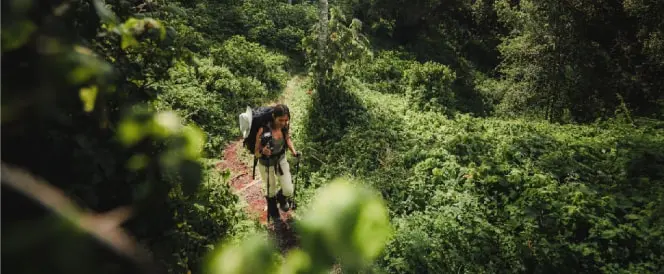
A guide and a mountain support crew will arrive at the hotel in the morning in order to meet you and hold a quick briefing, after which you will travel by vehicle to Kilimanjaro National Park's eastern entrance: Marangu Gate (1,860m/6102f). After the quick formality of acquiring climbing permits and registering with the search and rescue service, the group will start trekking up to Mandara Hut (2,720 m /8,922 f). The trekking route includes passage through the rainforest (where tropical showers are highly probable), so we recommend you take not only spare clothes but also your raincoats. When you reach the camp, our mountain support crew will take care of the necessities and prepare lunch.
Throughout the entire Marangu route, you will be spending your nights in special huts. They offer a great alternative to those who do not want to sleep in tents.
PLEASE NOTE:This will be your first day at this altitude, so it is strongly recommended you heed the following instructions from this point on:
- Abstain from consuming alcohol and caffeine;
- Drink over 4 liters of bottled water daily (little by little, frequently);
- To help alleviate symptoms of altitude sickness, consider using a preventive measure like a high-altitude aid medicine. Many mountain climbers take such pills in the morning, before they begin their ascent, to reduce discomfort associated with altitude sickness. Our managers will provide more specific details together with your travel itinerary. We recommend consulting your doctor prior to the trip to discuss any potential allergies or health concerns.
At night you may experience discomfort associated with acclimatization to the high altitude: because of a reduction in your breathing pattern at night, your body gets less oxygen than during the day. Taking altitude into account, you may therefore start feeling sick and experience a headache. Pay attention to your own body and tell your guide if you start feeling any symptoms of altitude sickness.
 Trekking time:
Trekking time:
 Distance:
Distance:
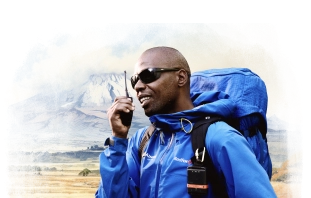
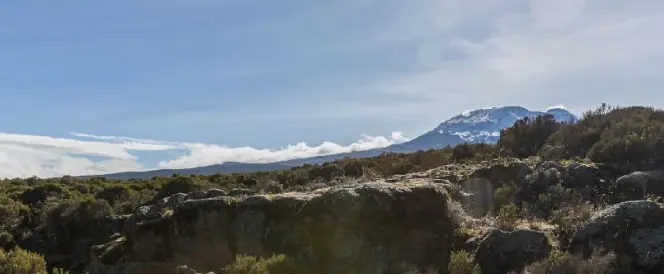
The group will wake early for a filling breakfast, and then depart Mandara Hut. This trek heads to the second high altitude camp: Horombo Hut (3,720 m /12,202 f). When you reach the camp on this day, you will be treated to views of two volcanos at once: Kibo and Mawenzi.
Several hours after lunch you will have to complete an acclimatization hike in the direction of Kibo Hut with a 200 m /656 f gain in altitude, and then hike back down to Horombo Hut where dinner will be prepared for you.
PLEASE NOTE:The acclimatization hike is an easy trek with a slight gain in altitude done in order to speed up the acclimatization process. You should take the acclimatization hikes very seriously. They help increase your chances of successfully summiting Kilimanjaro and save you from the consequences of altitude sickness.
 Change in Elevation:
Change in Elevation:
 Hiking distance:
Hiking distance:
 Hiking time:
Hiking time:
 Trekking time:
Trekking time:
 Distance:
Distance:
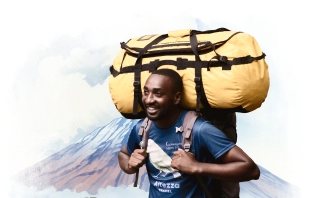
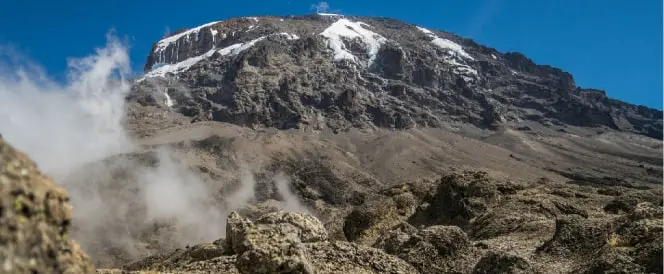
On this day, right after breakfast, the group will be trekking to the Kibo Hut (4,720 m /15,482 f). The actual trekking is not very difficult, just remember to stick with an appropriate pace to preserve your strength for the climbing to Kilimanjaro's summit. When you reach the camp you will be served lunch, after which we recommend you sleep as much as you can, avoid any strenuous activity, and drink lots of water.
 Trekking time:
Trekking time:
 Distance:
Distance:
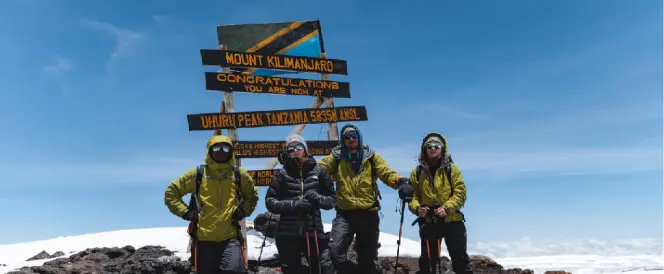
Your group will depart at night from Kibo Hut (4,720 m /15,482 f) and begin the trek to Kilimanjaro's summit: Uhuru Peak (5,895 m /19,336 f). The trekking will be moderate from a technical standpoint, but the altitude presents a challenge, making even regular physical activity feel strenuous. For the entire length of the summit trek, each pair of climbers will be accompanied by their own guide, who will be monitoring the pair's stamina and mental resolve. After your successful ascent to Uhuru Peak, you can descend to the nearest glacier if desired. Then you will return to Kibo Camp and enjoy a two-hour rest before continuing your descent to Horombo Hut (3,720 m /12,202 f).
PLEASE NOTE:Don't forget that 90% of all accidents occur during the descent, including most broken arms and legs. Please pay attention to your feet, as there is a high risk of damaging your toenails.
 Trekking time:
Trekking time:
 Distance:
Distance:
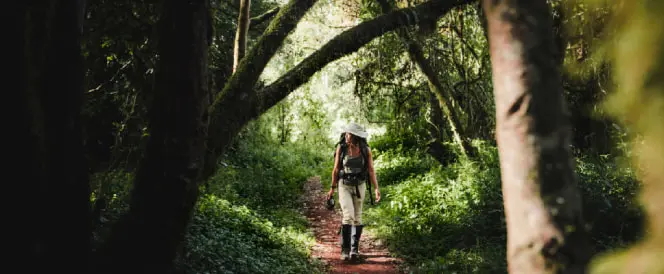
You will be offered a warm breakfast in the morning, after which we will head for the Kilimanjaro National Park's exit: Marangu Gate (1,970 m /6,462 f). After your descent, the whole group will gather to congratulate you, and then you will have the chance to share your opinions on the trip in the guestbook. Lastly, we will present you with your commemorative certificates and provide you with a transfer back to the hotel.
 Trekking time:
Trekking time:
 Distance:
Distance:
Rest in the hotel and transfer to the airport.
PLEASE NOTE:Hotel check-out is at 11:00 AM. In case you need a late check-out because of an evening flight, there is the option to extend your hotel stay for an extra fee.
Arrival at Kilimanjaro International Airport (JRO), where you will meet an Altezza Travel representative, and transfer to the hotel under the rate. The hotel will provide all the essentials for a comfortable stay: cozy rooms, hot water, polite staff, a swimming pool, and Internet access. In the evening there will be a briefing with our managers, who will also make sure you are ready to begin the climb.
Private tour packages include shared airport transfers for your group. Extra charges will apply for additional individual transfers. To avoid extra costs, sync your group's arrival and departure times.
PLEASE NOTE:Check-in starts at 2:00 PM.

Your climbing guide and a climbing support team will meet you at your hotel for a quick briefing, then you will drive to Kilimanjaro Park's Eastern Gate: Marangu, which lies at 1,970 m /6,462 f.
After finalizing the climbing permits registration with the rescue and search services, you will be ready to start your climb to Mandara Hut (2,720 m /8,922 f).
We highly recommend bringing a raincoat, as the trail passes through a tropical rainforest that has a high probability of rain.
Upon arriving at Mandara Hut, you will find lunch prepared and be assigned your hut for the night.
PLEASE NOTE:This will be your first day at this altitude, so it is strongly recommended you heed the following instructions from this point on:
- Abstain from consuming alcohol and caffeine;
- Drink over 4 liters of bottled water daily (little by little, frequently);
- To help alleviate symptoms of altitude sickness, consider using a preventive measure like a high-altitude aid medicine. Many mountain climbers take such pills in the morning, before they begin their ascent, to reduce discomfort associated with altitude sickness. Our managers will provide more specific details together with your travel itinerary. We recommend consulting your doctor prior to the trip to discuss any potential allergies or health concerns.
Discomfort associated with acclimatization is common at night when your body gets less oxygen than during the day. This is normally expressed in the form of nausea and headaches. Let your guide know if you experience any symptoms.
 Trekking time:
Trekking time:
 Distance:
Distance:


Your group will enjoy an early morning breakfast before departing Mandara Hut. This day's trek is a moderate hike towards the second high-altitude camp: Horombo Hut (3,720 m /12204f). When you reach the camp, you will be treated to views of two volcanos at once: Kibo and Mawenzi.
Several hours after lunch you will have to complete an acclimatization hike in the direction of Kibo Hut with a 200 m /656 f gain in altitude, and then hike back down to Horombo Hut where dinner will be prepared for you.
PLEASE NOTE:The acclimatization hike is an easy trek with a slight gain in altitude done in order to speed up the acclimatization process. You should take the acclimatization hikes very seriously. They help increase your chances of successfully summiting Kilimanjaro and save you from the consequences of altitude sickness.
 Change in Elevation:
Change in Elevation:
 Hiking distance:
Hiking distance:
 Hiking time:
Hiking time:
 Trekking time:
Trekking time:
 Distance:
Distance:

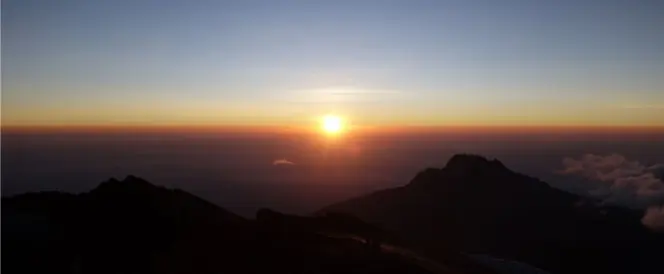
After breakfast, you will go on an acclimatization hike towards Kibo Hut and back to the camp.
Then, after lunch, you have the opportunity to walk around the surrounding area, take pictures of Mawenzi Volcano or just sleep before the upcoming trek to Kibo Hut. To enhance your acclimatization transition, the team will spend this night at the very same altitude at Horombo Hut camp.
 Change in Elevation:
Change in Elevation:
 Hiking distance:
Hiking distance:
 Hiking time:
Hiking time:

On this day, right after breakfast, the group will be trekking to the Kibo Hut (4,720 m /15,482 f). The actual trekking is not very difficult, just remember to stick with an appropriate pace to preserve your strength for the climbing to Kilimanjaro's summit. When you reach the camp you will be served lunch, after which we recommend you sleep as much as you can, avoid any strenuous activity, and drink lots of water.
 Trekking time:
Trekking time:
 Distance:
Distance:

Your group will depart at night from Kibo Hut (4,720 m /15,482 f) and begin the trek to Kilimanjaro's summit: Uhuru Peak (5,895 m /19,336 f). This stretch of the Marangu Route is not difficult in technical terms, but because of the high altitude, even regular physical activity feels strenuous.
For the final summit hike, we group two climbers with one guide, the guide will monitor their physical well-being, as well as provide encouragement and motivation for the final ascent.
After your successful ascent to Uhuru Peak, you can descend to the nearest glacier, if desired. Then you will return to Kibo Camp and after a two-hour rest, continue your descent to Horombo Hut (3,720 m /12,202 f).
PLEASE NOTE:90% of mountain accidents - including broken limbs - happen on the way down. However, they are easily avoided by taking care of how and where you step.
 Trekking time:
Trekking time:
 Distance:
Distance:

You will be offered a warm breakfast in the morning, after which we will head for the Kilimanjaro National Park's exit: Marangu Gate (1,970 m /6,462 f). After your descent, the whole group will gather to congratulate you, and then you will have the chance to share your opinions on the trip in the guestbook. Lastly, we will present you with your commemorative certificates and provide you with a transfer back to your hotel.
 Trekking time:
Trekking time:
 Distance:
Distance:
Rest in the hotel and transfer to the airport.
PLEASE NOTE:Hotel check-out is at 11:00 AM. In case you need a late check-out because of an evening flight, there is the option to extend your hotel stay for an extra fee.
Marangu Route FAQ
Machame route 6 days vs Marangu route 6 days
Both Machame and Marangu are frequently compared due to their popularity. The fact that Marangu is the only Kilimanjaro route with dormitory-style huts sets it apart. It is particularly suitable for climbing Kilimanjaro during the rainy season, alongside other northern Mount Kilimanjaro routes like Rongai 7. While both routes witness considerable foot traffic, Marangu's uses the same trail for ascent and descent, which can result in a more congested experience. Additionally, this fact somewhat narrows the variety of landscapes you encounter on the Marangu trail.
Hikers on both these itineraries have approximately 87% chance of reaching the highest summit of Mount Kilimanjaro. However, this rate is slightly lower compared to other extended itineraries that last 7 days or longer. This is primarily due to the more challenging acclimatization. If you’ve decided to choose between Machame 6 and Marangu 6, we would say that Marangu 6 might be a little easier.
Which route is better Marangu or Lemosho?
Both Kilimanjaro Marangu route and Lemosho route are chosen by thousands of hikers every year. Marangu route’s hut accommodation might appeal to some, while Lemosho offers stunning views, an easier acclimatization profile, and higher success rates, especially on its 7 and 8-day variations.
Marangu has another advantage that we can mention: there's an emergency road to Horombo Hut, at an altitude of 3,720 meters (12,205 feet). This means that in the rare cases when an evacuation is needed, it would be possible to organize it faster on this route. However, every camp on Kilimanjaro has a helicopter pad for evacuation cases that require immediate helicopter rescue.
What is the success rate of the Marangu route Kilimanjaro?
Nearly 84% of Altezza Travel hikers on Marangu 5-days and 87% of hikers on the 6-day itinerary make it to the summit. This is quite high compared to historic data or other operators. However, longer 7-day itineraries on other routes can offer even higher summit success rates.
Why is Marangu called the Coca Cola route?
The Marangu route itinerary on Mount Kilimanjaro is often referred to as the "Coca-Cola route" because it is perceived as one of the more "touristy" or "comfortable" routes to climb Kilimanjaro. However, while it may offer more basic amenities compared to other routes, the climb still presents significant challenges and requires adequate preparation and fitness. Climbers need to recognize that regardless of the route chosen, summiting Mount Kilimanjaro needs commitment and some preparation.
How hard is the Marangu route for climbing Kilimanjaro?
Marangu 6 days is a moderately difficult route accessible for a variety of climbers. However, its 5-day variation is significantly more difficult and we do not recommend it to beginners. The most challenging part of climbing Mount Kilimanjaro is usually the summit day in the high-altitude desert. Longer itineraries provide an opportunity to achieve better acclimatization and make the summit day more manageable.
How many days is the Marangu route?
The Marangu Route is available in two variations or itineraries: 5 or 6 days. The 6-day variation is a moderately challenging hike, while the 5-day Marangu route is recommended only for experienced high-altitude or those with good prior acclimatization.
What is the Marangu route known for?
The Marangu route is known as the oldest route on Mount Kilimanjaro and the only route where you don't need to sleep in tents. Its famous hut accommodation are also brought up every time the route is discussed. And for a cool fact: our friend Alexis Peltier once landed a plane near Kibo Hut on the Marangu route!
Marangu Route Reviews from clients
Others routes on Mt.Kilimanjaro











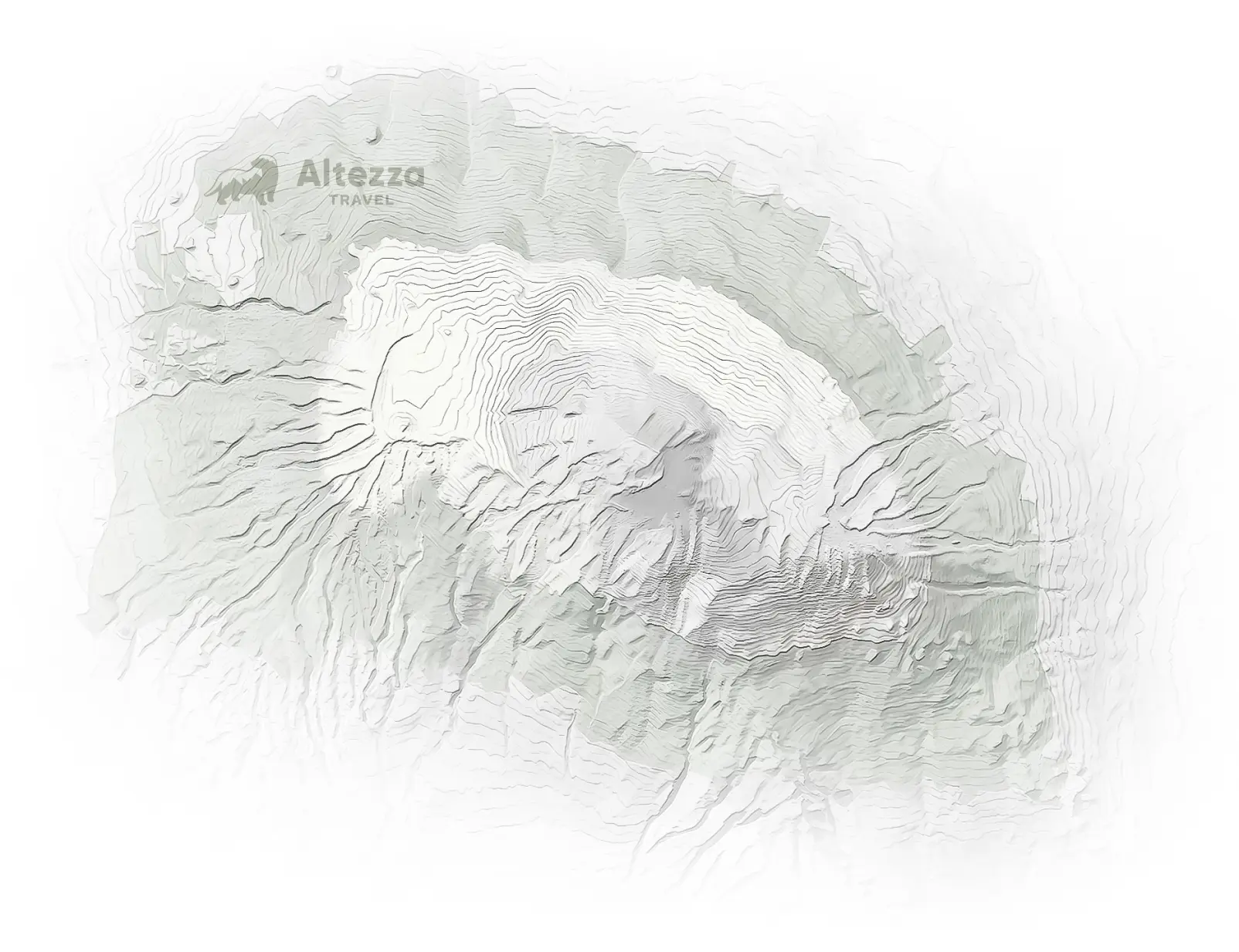
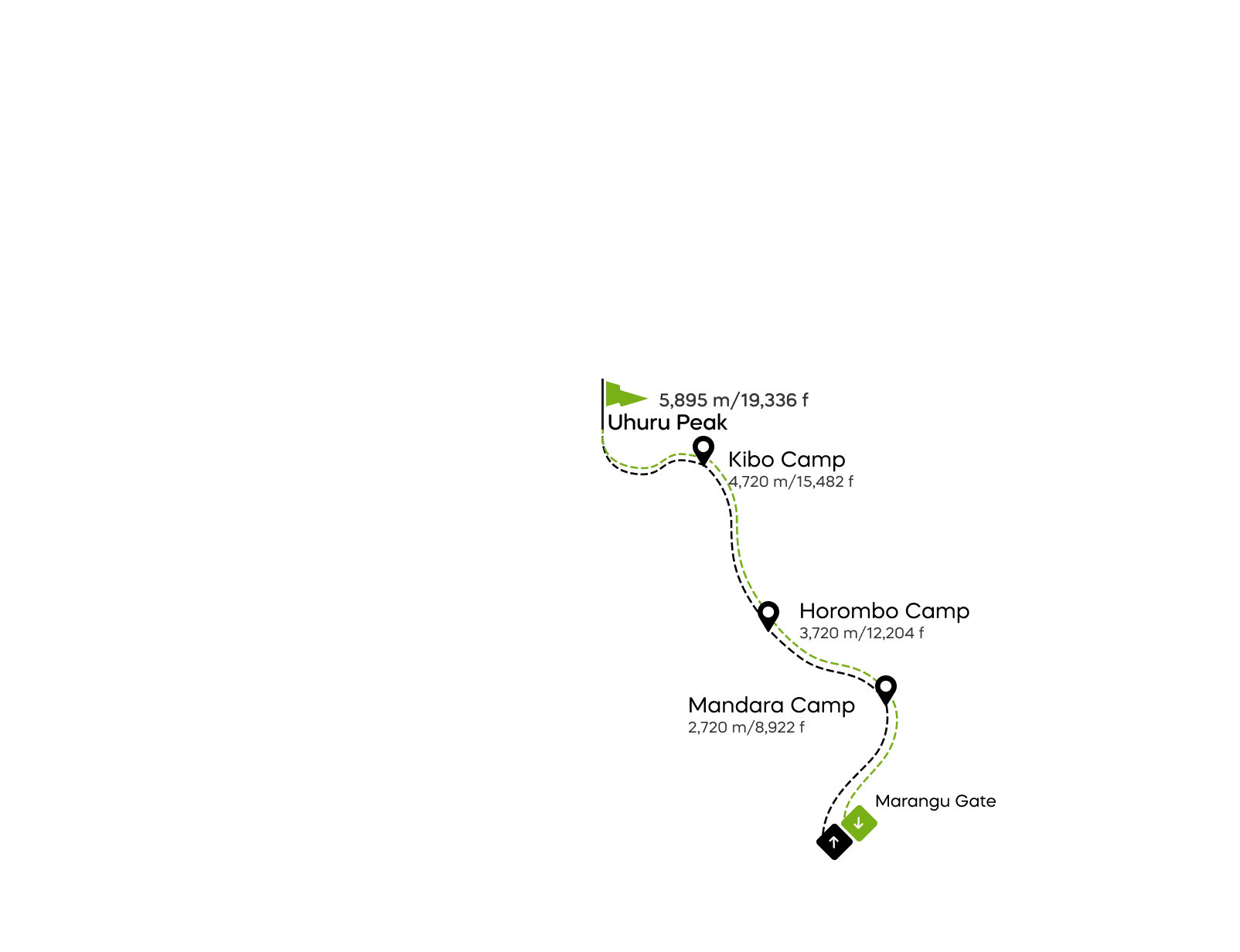



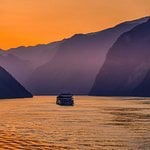
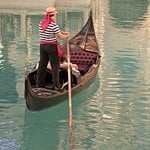
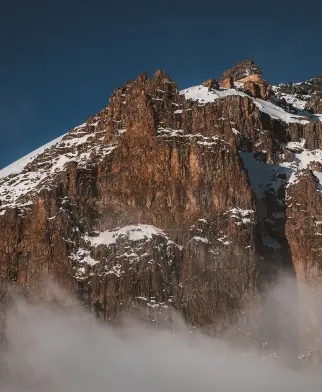
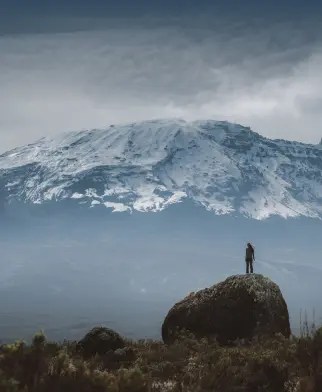
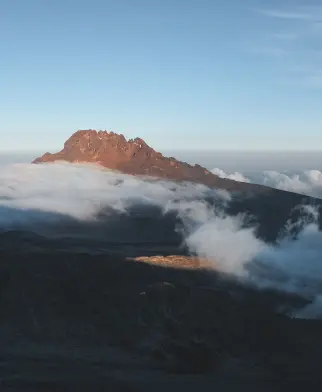
 View All Routes
View All Routes 
